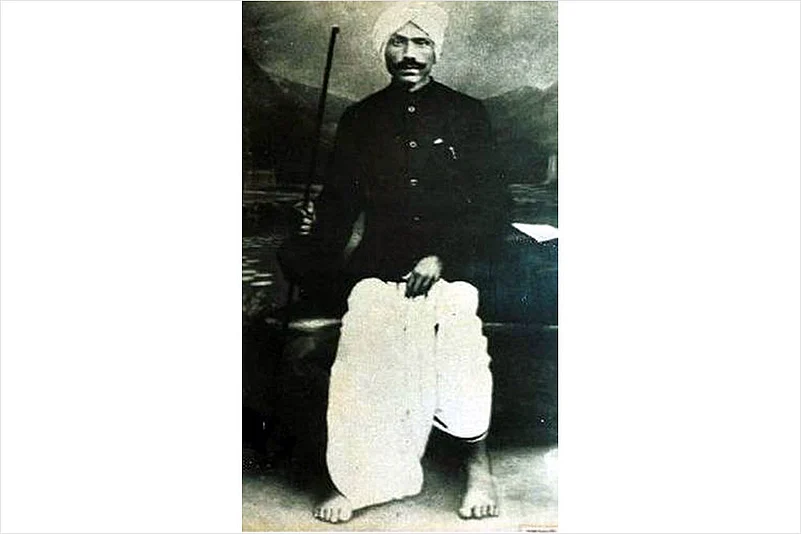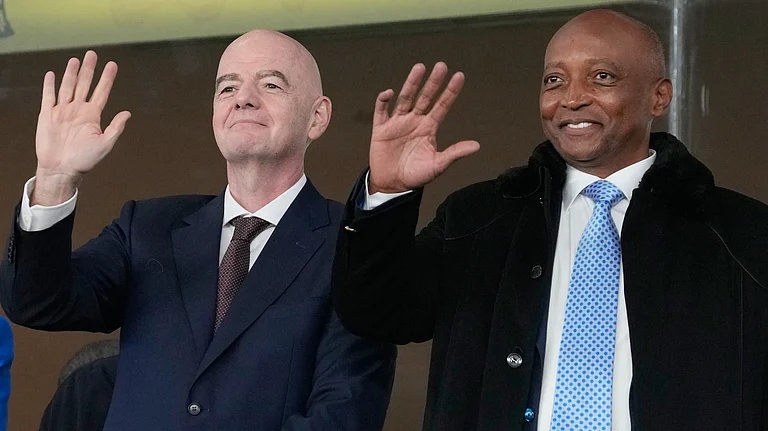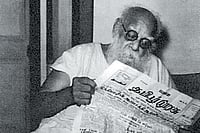Well-respected theatre personality T.K. Shanmugam had been using Bharati’s songs in his theatre productions from as early as the late 1920s. Shanmugam, following the success of his play Bilhanan (1948), based on the legendary eleventh-century Kashmiri poet of the same name, decided to turn it into a film. A song from Bharati’s Kannan Pattu, ‘Thoondil puzhuvinai pol’ (Like the worm in a bait—a song on the pining of a lover), which Shanmugam had used in the play, was to be included in the cinematic version as well.
Media mogul A.V. Meiyappan, who had bought the broadcast rights of Bharati’s songs from another businessman (who in turn had acquired it from Bharati’s family), sent a legal notice to Shanmugam, threatening to sue for copyright infringement if he dared to use Bharati’s songs in his film.
The legal notice, issued well before the release of the movie on January 29, 1948—about twenty-six years after Bharati’s death—stated that all recording rights of Bharati’s songs vested solely with Meiyappan and that no song may be used without his express permission. And if any song had been included in the film, he demanded its immediate deletion. If Shanmugam failed to do so, he threatened legal action and to claim for damages to the tune of Rs 50,000—an astronomical sum back then.
A shocked Shanmugam received the notice a few days after Gandhi’s assassination. Before pursuing the legal route, Shanmugam chose to confront the issue politically. First, he composed a pamphlet wrought with emotion. The single-sheet leaflet titled Bharati-kku Viduthalai Vendum! (Needed: Liberation for Bharati!) asked pointedly and forcefully:
Is it not shameful that in an independent India, some private individuals should claim title to the sweet poems of our Mahakavi? Dear friends, you rejoiced by building a manimantapam for Mahakavi Bharati and by commemorating Bharati Day. You desire that the immortal poet’s songs should spread all over the world...But have you realised that a hurdle has come up in our own country? Earlier, the government imposed a ban. Now some individuals are imposing a ban...Leaders such as Rajaji had unanimously declared at the Ettayapuram function that people should proudly sing Bharati’s songs.
But how are we to sing his songs? And where do we sing the songs? Are not individuals claiming them: ‘It’s my property! I own it!’...Is it right on your part to permit the immortal poet of Tamil Nadu to be locked up in an iron safe and made a matter of business?
Even though legally this case has to be judged in a court of law, we have every right to ask the people living in a free country: Who owns Bharati?
Why should the Madras government not issue a proclamation that ‘Bharati’s poems and writings are the property of Tamil Nadu. No individual has any right over it. The nation has become free. But is there no freedom for Mahakavi Bharati, who sang for the nation’s liberation, even twenty-five years after his death?
Given his standing in the public sphere, Shanmugam did not take Meiyappan’s legal challenge lying down. He did not stop with sending letters to the government and printing leaflets. In mid-April, 1948, he first went to Chennai and later to other parts of Tamil Nadu, launching a public campaign for the government takeover of the copyright of Bharati’s works.
Shanmugam met Narana Duraikannan in Chennai, who, despite not being a great writer, was widely respected for his humane qualities. Later he conferred with Va.Ra., Nellaiyappa Pillai and T.P. Meenakshisundaram. Va.Ra. had been a close confidant of Bharati from his Pondicherry days and had penned the influential biography and character sketch of Bharati at the height of the ‘mahakavi’ controversy. Nellaiyappa Pillai, a great admirer of Bharati and referred to by the poet himself as ‘thambi’ (younger brother), had been his publisher in his own lifetime. T.P. Meenakshisundaram, renowned literary man and linguist, had a formidable reputation as a scholar. Shanmugam evolved a consensus among such widely respected cultural figures and sought their blessings and good wishes for the campaign to nationalise Bharati’s writings.
Following this confabulation, Shanmugam’s discussions with Narana Duraikannan and Vallikannan (then an emerging writer and journalist and later a respected literary historian) continued late into the night on the sands of the Marina Beach. The next night, accompanied by the above two friends, he set out towards Tirunelveli on what came to be known as the Bharati Liberation Yatra. The group disembarked midway at Tiruchirappalli, and a few more cultural personalities joined the yatra. On April 21, 1948, unmindful of the rush, the group travelled by the Shencottah passenger train and reached Tirunelveli at noon the following day to meet Bharati’s wife Chellamma.
The league met Chellamma as well as his daughter, Thangammal, at their Kailasapuram residence near the railway junction. Chellamma said she had no objection to her husband’s works being nationalised. The league had carried T.S. Chockalingam’s letter asking if she was agreeable to the idea of nationalising Bharati’s works; as we shall soon see, the respected journalist Chockalingam was education minister Avinashilingam’s pointsman for non-official handling of the issue. Shanmugam states that on April 23, 1948 Chellamma gave a letter in the affirmative.
Even though Chellamma had given away all her rights to Bharati’s half-brother much earlier, and as such had no locus standi legally speaking, her consent gave much legitimacy to the demand for nationalisation. Given his stature and contribution to both the arts and nationalism, Shanmugam had considerable credibility. He worked in tandem with others to conduct meetings across Tamil Nadu in support of the demand. In government files we find resolutions passed by various organisations such as the Dindigul Town Congress Committee and the Salem Municipal Council calling for the nationalisation of Bharati’s works, indicating the widespread support the campaign was gathering.
Meanwhile, Meiyappan initiated legal proceedings. Apart from Shanmugam’s T.K.S. Bros., he sued Salem Shanmuga Films of Coimbatore, Ramanathan Pictures of Karaikudi, Sankar Pictures of Srirangam and Jaya Films of Salem, all involved in the production of Bilhanan.
As the campaign for nationalising Bharati’s works gathered steam, the government of Madras state, in a newly independent country, had to reckon with it. Given Shanmugam’s association with the freedom struggle and proximity to political personalities, he had taken the battle to the government. He wrote two letters, one to Premier Ramaswamy Reddiar and the other to Dr T.S.S. Rajan—an associate of V.V.S. Aiyar and V.D. Savarkar during their London days—a prominent Congressman, a trusted associate of Rajaji and minister of food and public health in Ramaswamy Reddiar’s cabinet. The latter letter was immediately passed on to education minister T.S. Avinashilingam.
Premier Ramaswamy Reddiar instructed education minister Avinashilingam to handle the issue, and in a matter of a day, the premier’s instruction changed from merely exploring the possibility of acquiring the copyright to finalising a decision on government takeover. Quite understandable, since the Congress was committed to Bharati and well knew the emotional appeal the issue possessed in the popular imagination.
Understanding the mood of the public, Meiyappan offered to assign his copyright as a gift to a trust which would be composed of himself (or his nominee) and two or more government nominees. Requests to use Bharati’s works, he suggested, could be made to this trust, which would finalise the terms. As for his own use, he requested that permission be given as a matter of routine and without payment.
Clearly, public pressure was on Meiyappan and he did not want to draw either public displeasure or government disapproval. In fact, he was making a virtue out of a necessity. But what he was offering was too complicated and came too late in the day for the government to consider seriously.
The wheels of the government turn but slowly. This was especially true for the new government in independent India which was a stickler for procedures and formalities. It ultimately took about a year for the intent of Ramaswamy Reddiar’s marginal note to Aviniashilangam, in the document on the nationalisation of Bharati’s works, to be translated as a pronouncement on the floor of the Legislative Assembly.






















